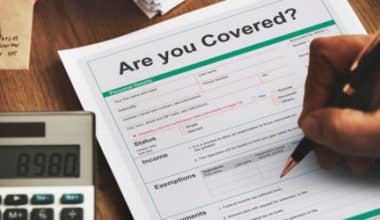Some drivers are deemed “high-risk” by insurance providers. Insurers may view these motorists as more of a risk because of factors like their driving histories, the vehicles they drive, and even their credit ratings. The insurance company may view them as a higher risk, making premiums rise. This article talks about what high-risk auto insurance is, its cost, and the best cheap ones.
Overview
Drivers with poor driving histories (those with multiple citations, accidents, or DUI/DWI convictions) may have a more difficult time locating affordable insurance than those with spotless records. However, whether or not you have a clean driving record, most states mandate that you carry auto insurance coverage. This means that high-risk drivers may still need to shop around for a policy that meets their needs. If you shop, you can obtain low-cost, high-risk auto insurance. The following are some factors to consider before looking into high-risk auto insurance:
#1. Some Car Insurance Providers Don’t Provide Coverage for High-Risk Drivers
There are insurance providers who will only cover those with spotless records. In some cases, drivers may need “non-standard auto insurance,” often known as “high-risk insurance.”
#2. It Is Still Possible to Shop Around for High-Risk Auto Insurance
You may and should compare auto insurance policies, just like you would with any other product or service. Consider both the policies’ prices and the extent of their protections before settling on a high-risk insurance provider. You should search for an insurance provider that excels in all three areas: customer service, policy variety, and cost. There are still insurance providers who will work with you despite your driving record or current financial condition if you look hard enough.
#3. You Can’t Get Insurance With a Sr-22 Endorsement Because There Is No Such Thing; It Is a Form Application
A Form SR-22 is not insurance, despite popular belief. An SR-22 is a certificate of financial responsibility filed by an insurance provider with the state to verify that a driver carries the minimum insurance coverage required by law. Those who have been convicted of serious traffic offenses may be ordered to obtain an SR-22 from the court or the state. Unfortunately, not all insurance providers offer SR-22s, so if you need one, you’ll have to shop for it.
#4. You Can Change From a “High-Risk” Status Over Time High-Risk Drivers Can Find Reasonably Priced Auto Insurance Coverage
A driving infraction will remain on your record for the amount of time required by your state of residence, but your insurance provider may be able to offer advice on how to minimize the impact on your record. Some high-risk auto insurers offer discounts to policyholders who complete a defensive driving or traffic school. By working to improve your driving record, you can reduce the risk you pose to insurance companies and save money on auto insurance.
- Drive defensively to reduce the likelihood of being in a collision.
- Take care to abide by all parking and traffic regulations.
- Consider upgrading to a vehicle with more robust safety options.
What Is High-Risk Auto Insurance
High-risk auto insurance is simply an auto insurance policy created for a driver who is assessed to have a higher possibility of submitting a claim. Auto insurers will assess your risk of filing a claim and adjust your premiums accordingly. Insurance firms may charge more for high-risk drivers to compensate for the added financial risk they present.
High-risk vehicle insurance is typically associated with things like repeated speeding tickets or a DUI, but each insurance company has its own definition of what constitutes risky driving and may be more or less likely to give coverage depending on your specific rating factors. A high-risk driver is more likely than the average motorist to claim on their auto insurance policy. Insurers may label you a risky motorist for a variety of reasons, some of which are:
#1. Age
Teens and young people have a greater accident rate than senior citizens because they lack driving experience. However, neither Hawaii nor Massachusetts utilize age as a rating factor for auto insurance, so teenage drivers in these jurisdictions shouldn’t be deemed high-risk unless there are other factors at play.
#2. Disobeying Traffic Laws
One or more fines for instances like speeding or disobeying traffic signals may boost your premiums.
#3. Mistakenly Caused Mishaps
If you cause an accident and your insurance company finds out who was at fault, they may view you as a higher risk for future accidents.
#4. DUI/DWI Convictions
The consequences of driving under the influence or while intoxicated are many and severe. Car insurance premiums tend to skyrocket after a conviction for driving under the influence.
#5. Irresponsible Driving
Convictions for reckless driving, such as running a red light or swerving in and out of traffic, may increase your chance of causing an accident, and, as a result, your insurance premiums may increase.
#6. Poor Credit
The majority of states allow insurance companies to consider credit history when determining rates. Insurance companies may raise rates for drivers with low credit scores since they are more likely to file claims. The states of California, Hawaii, and Massachusetts ban using credit scores in rating decisions. Insurance companies in Michigan can use part of the information that goes into a customer’s credit score, but the state does not permit credit scores to be used as a component in rate calculations.
#7. Lapses in Coverage
Almost every state has made it mandatory for drivers to carry auto insurance. Allowing your auto insurance to lapse can make you a high-risk customer while shopping for new coverage.
All of these aspects are not the same. Even if you only have one traffic ticket or a minor at-fault loss on your record, you may not be considered a high-risk driver. However, a single DUI or reckless driving conviction will almost certainly qualify you as a high-risk driver. As an added complication, high-risk drivers are assessed differently by different insurance providers.
Poor drivers may pay more for auto insurance, but they still enjoy the same protections as good drivers. Most drivers have access to the same coverage options provided by the finest high-risk vehicle insurance companies. There are a variety of coverage additions that may be made to your auto insurance policy by different companies. Liability insurance is required by law in every state that makes it mandatory to have auto insurance, and many states need extra types of coverage as well. Standard insurance coverage includes
#1. Bodily Injury Liability (BI)
If you cause an accident and are judged at fault, the other party’s medical bills and lost wages will be covered by your insurance.
#2. Property Damage Liability (PD)
Pays for the repairs or replacement of other people’s vehicles and property if you cause an accident and are proven at fault.
#3. Personal Injury Protection (PIP)
It will pay for your medical expenses and missed wages if you’re in an accident, no matter who was at fault.
#4. Medical Payment Coverage (MedPay)
It pays for everyone’s medical bills, regardless of who was at fault but does not compensate for missed pay.
#5. Accidents With Drivers Who Do Not Have Insurance Are Covered
If the other motorist does not have enough insurance to cover injuries and property damage, your policy will.
Some of the finest high-risk auto insurers also provide coverage choices as add-ons. Full-coverage auto insurance consists of state-mandated liability and injury protection plus the following features:
#1. Collision Coverage
Damages to your vehicle and other property in a covered collision are paid for regardless of responsibility.
#2. Comprehensive Coverage
It protects your car in the event of theft, hail, or flooding, in addition to accidental damage.
Other than collision and comprehensive coverage, most insurance companies also provide additional, supplemental coverage. These may help provide comfort and supplementary assistance, but they will increase your overall premium.
Best High-Risk Auto Insurance
The rates offered by the largest auto insurance providers in the country were broken down into four groups to help high-risk drivers like yourself find the best policy: drivers with spotless records, drivers with one at-fault accident, drivers with one speeding ticket conviction, and drivers with one DUI conviction.
If you require high-risk auto insurance, you should know that you should expect to pay more than safer drivers. The following insurers provide reasonable rates and comprehensive policies for autos:
#1. Amica
Amica stands out as an alternative for high-risk drivers due to its competitive average pricing for both drivers without citations or accidents and drivers with tickets or accidents, as well as its high satisfaction with their claims satisfaction score from J.D. Power. The legacy discount is an unusual perk that could help keep insurance costs down for newer drivers. If your parents have been Amica customers for at least five years, you could save on your auto insurance if you’re under 30. If you have had many DUIs or need an SR-22, you may want to speak with an Amica agent in person.
#2. Geico
After a DUI conviction, you may require high-risk auto insurance and Geico could be an excellent option. A DUI will result in a significant rise in your annual premium, but the average increase at Geico is less than the national average. Geico may be able to file your SR-22 or FR-44 for you if you need to get your driver’s license reinstated. Geico offers a wide variety of discounts to its customers, some of which could reduce premium costs even further. The military, good students, telematics users, and others may all be eligible for discounts.
#3. Allstate
Compared to other companies, Allstate’s average vehicle insurance premiums after an incident may be higher, but the company does allow SR-22 filings. Allstate also offers some discounts that could reduce monthly payments. If a new policyholder signs the paperwork at least seven days before the policy’s effective date, they may be eligible for a discount. The responsible payer discount may be available to policyholders who maintain a perfect payment history throughout the policy’s duration. With Allstate’s Drivewise telematics programme, responsible drivers are rewarded with a discount on their auto insurance premiums every six months.
High-Risk Auto Insurance Cost
The typical premium for high-risk car insurance is $234 monthly or $2,802 per year. That’s $1,164 higher than the annual cost of car insurance for a person with a spotless driving record in the United States as a whole. Even though high-risk drivers’ insurance will always be more expensive than that of a safe driver, the actual premium will vary by insurance provider, infraction, and other factors.
The national average for vehicle insurance premiums is $1,730 per year for full coverage, but high-risk drivers can expect to pay much more than that. Your risk factors may increase your premium, but the exact amount may vary by insurer and cause. Your auto insurance premium is determined by more than just the aforementioned factors. When calculating premiums, insurers also consider the following factors:
#1. Location
Not only are there price variations between states, but also within them. Auto insurance premiums tend to be more expensive in places with a greater incidence of crime and severe weather.
#2. Credit score
When determining your premium, insurance firms may consider your credit history in states where this is permitted. Insurance premiums tend to be significantly higher for drivers who have low FICO scores since they are seen as a greater financial risk.
#3. Marital status
The average car insurance premium is lower for married drivers because they are more likely to bundle their auto coverage with other types of insurance or insure several vehicles.
#4. Vehicle
Your premium is based on several factors, including the worth, condition, and miles of your car.
#5. Coverage
Your premium will vary greatly depending on the extent and type of coverage you purchase.
#6. Deductible
The deductible is the amount you will have to pay before your insurance company begins to pay for a covered loss. In most cases, lowering your deductible will result in a higher premium for your car insurance.
#7. Discounts
You can still find low-priced insurance even if you have a few marks on your driving record or are at higher risk in some other way. Many insurance companies provide discounts on auto coverage to customers who meet certain criteria.
High-Risk Auto Insurance Cheap
To begin searching for low-cost auto insurance for high-risk drivers, one must first define that category. Driving-related factors include things like getting a ticket, getting into an accident, or getting a DUI. Lack of experience (such as that of a young driver), gaps in coverage, and low credit scores can also play a role. However, certain states (such as Massachusetts and Hawaii) forbid using age or credit history as a factor in premium pricing. Below are the cheap, high-risk auto insurance options, which include the following:
#1. USAA
Even if you have a history of traffic violations or accidents for which you were at fault, USAA may provide you with affordable coverage. Customers have a very positive impression of the business. However, this insurer only covers people with a military background, such as active-duty personnel, veterans, and their families.
#2. Progressive
Since Progressive’s typical auto insurance premiums are cheaper for drivers who have filed for an SR-22 or been convicted of a serious driving offense like DUI, they may be a popular choice among both young and high-risk drivers. The carrier’s “Name Your Price” tool may help you identify coverage options that work within your budget if you’re having problems doing so. Discounts for automatic billing, homeownership, and participation in the insurer’s telematics programme may also be available to policyholders. If you’re considering buying insurance from Progressive, you might want to talk to current customers first, as the company received a below-average claims satisfaction score from J.D. Power.
#3. State Farm
The research shows that State Farm has the highest overall and high-risk driver satisfaction rates of any auto insurer. According to J.D. Power’s rankings of widely available auto insurance providers, it has the highest customer satisfaction and some of the lowest rates for drivers with moving violations, moving accidents, and driving under the influence. AM Best has awarded it its top rating of A++, signifying that they are in excellent financial standing. All 50 states are included, which is a huge plus.
How Does Risk Insurance Work?
For risk insurance to function, policyholders must pool their risks by paying premiums to an insurance firm, which will then use those premiums to pay for losses that are covered by the policy.
What Is an Example of a Risk Insurance?
Insurance risks can come in the form of natural disasters like fires or man-made ones like being judged legally accountable for someone else’s injuries or property damage.
What Is the Difference Between Risk and Insurance?
Insurance, in the context of economics, is a pool of money meant to reimburse those who have experienced a loss. Risk, as used in the context of insurance, is defined as “the possibility that something bad will happen that will result in financial losses.”
What Does All-Risk Insurance Cover?
Open danger insurance, commonly known as “all risks” insurance, protects against any peril not specifically excluded in the policy’s terms. Several fields make use of all-risks policies. Agriculture, commerce, machinery, and property are only a few examples.
What Are the 4 Categories of Risk?
The following are:
- Strategic risk.
- Compliance and regulatory risk.
- Financial risk.
- Operational risk.
How Do I Calculate Insurance Risk?
Multiplying the potential “value” of a loss with its frequency or likelihood of occurring yields a measure of risk. There may be no discernible difference between the “risk” posed by an event with a high impact but low frequency and an event with a low impact but higher frequency.
What Is the Best Car Insurance for People With Bad Records?
In general, drivers with poor driving records can find the best rates at USAA, Erie, GEICO, and State Farm.
What Are the 3 Types of Insurance Risks?
Most pure risks fall into one of three categories: those that threaten the insured’s capacity to make a living, those that threaten the insured’s possessions, and those that cover losses that result from the insured’s relationships with others. Private insurers do not often cover 100% pure risks.
Conclusion
The necessity of high-risk auto insurance is based on your driving record. Some vehicles and motorists are more prone to collisions than others. The cost of their auto insurance reflects the increased risk they pose. You may want to compare several insurance options depending on your specific needs. Your auto insurance rate will be determined by the business you choose and the risk it assigns to you. Make sure you’re getting the proper price for the level of coverage you need by comparing quotes from multiple auto insurance providers.
- GOOD2GO CAR INSURANCE: 2023 Review Rates, Coverage, Pros & Cons
- SAFE AUTO INSURANCE REVIEW 2023: All to Know
- Can You Get Car Insurance Without a License? Explained!
- HOW MUCH IS MOTORCYCLE INSURANCE: 2023 Cost Guide.
- DIFFERENT TYPES OF INSURANCE: Detailed Guide






